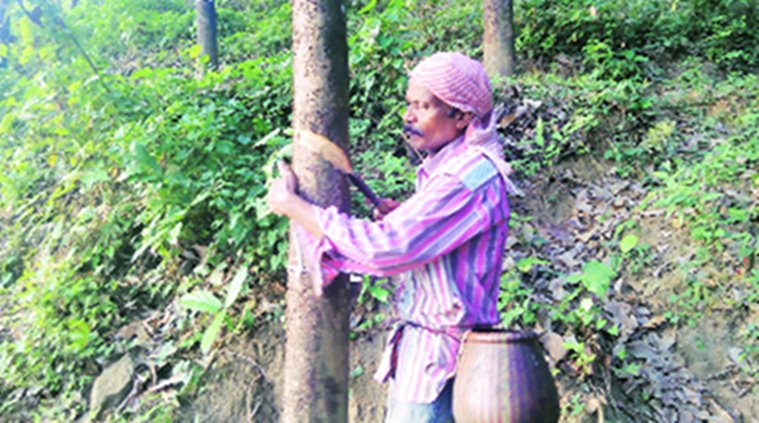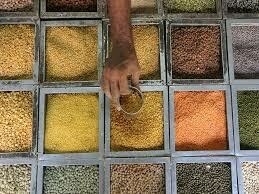The above increase — linked mainly to rising global crude oil prices, which have also made synthetic substitutes such as styrene butadiene rubber more expensive — has cheered growers here.

Alabourer taps rubber from a tree at a plantation in Kottayam, Kerala. (Express Photo by Shaju Philip)
This is one crop that seems to have bucked the demonetisation blues. Since November 8, the day the Narendra Modi government announced the outlawing of all existing Rs 500 and Rs 1,000 denomination currency notes, prices of natural rubber have gone up from Rs 117 to Rs 143 per kg for first-grade ‘RSS-4’ sheets traded in Kerala’s Kottayam market.
The above increase — linked mainly to rising global crude oil prices, which have also made synthetic substitutes such as styrene butadiene rubber more expensive — has cheered growers here. In the recent past, they have witnessed RSS-4 prices in Kottayam swing from Rs 240-plus in February 2011 to a low of Rs 91 per kg in February 2016, before the current recovery that has, coincidentally, happened post-demonetisation.
At Pala, Kanjirapally and other high-range areas of Kottayam in the central Kerala rubber heartland, growers have managed to overcome the impact of demonetisation, thanks not only to improved realisations but also the prevailing practice of marketing their produce. Although tapping of trees is done every alternate day, most farmers sell natural rubber sheets, processed from the extracted milky latex, only once or twice in a month. When prices go up, farmers hold back their produce in the expectation of making gains from delaying sales.
“Since we were anyway used to receiving money once a month, it (demonetisation) did not really hit us. So long as prices are good, which they are now starting to be, we have had no problems accepting payment by cheque,” says Balachandran Pillai, a rubber grower from Chenappady village in Kottayam’s Kanjirapally block.
Moreover, growers have been cutting costs by resorting to sale of latex, as opposed to rubber sheets. Production of the latter entails extra expense on labour and formic acid (for coagulation of the latex into sheets). At peak rubber sheet yields of 7 kg per acre, labour costs alone — at Rs 2 per tree and 150 trees per acre — work out to Rs 300 or Rs 43/kg. If only latex is produced — in which case, growers have to just add small quantity of ammonia to prevent its premature coagulation — the labour cost can be contained within Rs 1.5 per tree.
“Many farmers here had shifted to selling latex even prior to demonetisation. I have myself been selling only latex in the last two years. The latex procuring firms pay once a month. The last payment I got was for November. For December, it should come next week,” adds Pillai.
Jose Jacob, a 600-tree grower from Chirakkadavu, a village near Kanjirapally town, notes that in the initial days following the notes ban, there was an issue with encashing cheques issued by traders. “They would have accounts in banks different from ours, which meant that the encashing of cheques took time. But now, traders have started directly crediting payments to farmers’ accounts,” he points out.
After Demonetisation Hits Prices, Farmers Distribute Free Vegetables
The system of direct fund transfer predating demonetisation has, in fact, been a major factor that has helped rubber growers here to tide over currency crunch woes. In July 2015, the Kerala government had introduced a rubber support price scheme. It ensured a minimum price of Rs 150 per kg for farmers having up to two hectares of land under rubber cultivation. Under the scheme, farmers could sell to their local rubber producers’ societies (RPS) or dealers at the prevailing market price, based on the daily reference rates published by the Rubber Board, and submit the bills through their society. The difference between the support price of Rs 150 per kg and the notified market price would, then, be transferred to their bank accounts.
Around 4.5 lakh marginal farmers had, even before demonetisation, registered under the scheme, with their bank accounts linked to that of the RPS in their respective areas. “We have 300 rubber growers registered with us. As we were handling monthly payments of around Rs 8 lakh under the support price scheme, it was decided to also introduce an online fund transfer facility. Around 175 farmers were availing of this facility before the notes ban. After the ban, some farmers having accounts with cooperative banks faced trouble. But now, everybody has opened accounts with commercial banks and we have gone fully cashless,” explains Binny Mathew, general secretary of the RPS at Iykombu near Pala.
Some of the producers’ societies – which collect rubber sheets or latex from farmers for selling to user industries – are even maintaining tappers’ banks (pool) for supplying labour to their members. “Apart from transferring bill amounts to our members’ accounts, we are also paying tappers through the same route. These are reimbursed by the growers when they get their payments either credited to their accounts or by encashing of cheques. This should work well when prices of rubber are on the rise, as they are currently,” observes Shajimon Jose, secretary of the RPS at Chirakkadavu.
Jose Jacob claims there are no major problems with regard to paying tapping labour: “We had from the start of demonetisation itself minimised our expenses in a manner so as to not affect payments to tappers. Now that banks are giving us Rs 24,000 every week, problems on this front have been further sorted out.”
According to Tomy Abraham, president of the Indian Rubber Dealers Federation, small-scale traders in remote villages who deal with a few kilograms of produce daily, are the ones that have been affected by demonetisation. “Most traders are in the process of switching over to online fund transfer systems. Payments and transactions have now become transparent,” he admits. He also believes that this is the right time for the government to provide an export incentive of Rs 10 per kg for natural rubber. This will help raise prices to Rs 170 per kg – which is what RSS-4 rubber is today trading at in Bangkok – and do away with the need for the existing Rs 150 per kg support price scheme.
Between 2011-12 and 2015-16, India’s natural rubber production fell from 903,700 tonnes to 562,000 tonnes, largely in response to prices declining from Rs 208.05 to Rs 113.06 per kg (average for RSS-4 grade, Kottayam). During April-November 2016, however, domestic output has been 428,000 tonnes, 12 per cent more than the 382,000 tonnes for the same period of 2015. With prices, too, hardening, growers have finally something to smile about – with or without demonetisation.


























